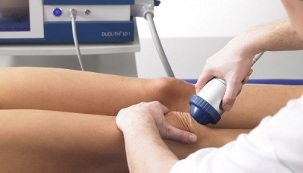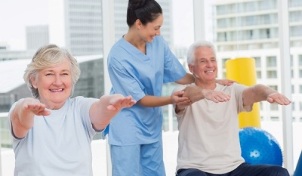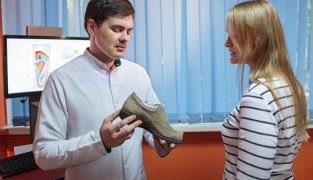
Arthrosis involves joint damage and degenerative-dystrophic changes. This requires competent and timely treatment. This may involve a complex of conservative methods or may require surgery.
Arthrosis is a chronic, degenerative-dystrophic disease. This includes the destruction of cartilage and pathological changes in the capsule, synovium, ligament devices, and adjacent bone structures. Pathology requires an integrated approach to treatment.
Medication
One of the main areas of conservative treatment of arthrosis is the use of drugs. The following medications are usually prescribed:
- Non-steroidal anti-inflammatory drugs. They relieve inflammation, pain and fever.
- Glucocorticosteroids. These medications also relieve inflammation and pain, but are more effective.
- Analgesics. These include painkillers and some NSAIDs.
- Chondroprotectors. Such drugs are used in long courses. They are needed to restore the affected cartilage structures.
- Muscle relaxants and antispasmodics. These medications also relieve pain by eliminating muscle cramps.
- If arthrosis is a consequence of gout, anti-gout medications are needed.
- vasodilators. Such drugs have a vasodilating effect. A
- Compressors are effective in treating arthrosis using medical bile and other devices.
- Vitamin and mineral complexes. They are needed to activate immunity, normalize metabolism and metabolic processes, replenish and assimilate missing elements. Calcium supplements are usually prescribed.
Individual choice of medications is often wrong. The attending physician should prescribe medications and determine the characteristics of their use.
Physiotherapy
Treatment of arthrosis usually involves a variety of physiotherapy procedures. They are used as part of conservative therapy and are prescribed after surgery to speed healing and reduce the risk of complications.
The following procedures are effective for arthrosis:

- laser therapy- heat effect to stimulate regeneration;
- magnetotherapy- increase of vascular tone, activation of metabolic processes, acceleration of healing, alleviation of inflammation;
- ozokeritotherapy- warm-up to improve microcirculation and relieve pain;
- electrophoresis- administration of drugs by electric current;
- cryotherapy- exposure to low temperatures to relieve swelling, pain, reduce muscle tone;
- ultrasound- exposure to high frequency sound to improve metabolism;
- UHF therapy- softening of calcium deposits, normalization of metabolism, reduction of edema;
- homeosiniatry- introduction of homeopathic medicines into biologically active points.
Physiotherapy procedures are contraindicated. These include exacerbation of the inflammatory process, pregnancy, active tuberculosis. There are a number of limitations to each procedure.
Massage
Massage is used in the remission of arthrosis or in the subacute period. In the case of acute illness, such treatment is ruled out, as the affected joints need complete rest.
Arthrosis massage has the following effects:
- analgesia;
- return to mobility, eliminate rigidity;
- activation of blood circulation and lymph flow;
- prevention of muscle atrophy, strengthening of the muscle ligament;
- Improvement of metabolic processes and tissue trophism.
The characteristics of a massage depend on which joints are affected. In any case, such therapy should only be performed by a qualified professional. Before the massage, you need to assess the degree of mobility, the condition of the muscles, identify contractures, ankyloses, pain points.
The effectiveness of the massage is ensured by the application of the course. The number of sessions is determined individually. Massage courses need to be repeated from time to time - their frequency is also chosen individually.
gym therapy
Physiotherapy is actively used for osteoarthritis. It is needed to activate blood circulation and metabolic processes, restore joint mobility and strengthen the muscle ligament. In the initial stage, the gym therapy should be performed under the supervision of an instructor.
You can do a home tournament in the future:

- Lie on your back on a solid surface and stretch your legs. Bend one leg at the knee, keeping your leg 5-10 cm above the floor. Lock in this position for 5 seconds, return to starting position. Perform 5 reps alternately on each leg.
- The starting position is the same. Bend one leg and press it with your hand to the body. Repair for a few seconds. Then place your foot on the floor and slowly align your limb. Perform 10-15 reps on each leg.
- The starting position is the same. Raise your straightened leg 25-30 cm above the floor and secure for a few seconds. Return to starting position. Do 20-30 reps on each leg in a row.
- Lie on your stomach. Bend your knees alternately, trying to reach your buttocks with your heels, but without lifting your hips off the floor. Perform 20-50 repetitions on each leg.
- The starting position is the same. Bend your knees alternately, fixing yourself for a few seconds at the outermost point. Perform 10 reps on each leg.
- Sit down and straighten your back. Alternately bend and bend your legs at a moderate pace. You can do the exercise with little weight in the future.
- The starting position is the same. Raise your leg to form a right angle. Record for 3 seconds and return to starting position. Perform 10 reps on each leg.
Osteoarthritis can affect different joints, so the series of exercises should be special in each case. This should be developed by a specialist, taking into account the individual characteristics and illness of the patient.
All exercises should be performed smoothly, excluding sharp movements. Your breathing should be monitored during the gym - you should be calm and measured.
Lifestyle
Treating arthrosis involves lifestyle changes:
- If you are overweight, you need to normalize. This moment is especially important in the case of damage to the lower extremities.
- Moderate physical activity. High loads should be ruled out, so professional sports should not be practiced. The best solution is physiotherapy exercises and regular walking.
- Attentive attitude to your health. Treatment of chronic diseases, intake of periodic vitamin-mineral complexes, preventive examinations by a doctor are required.
- Choose the right clothes and shoes. One should not feel shy. Tight clothing causes blood stagnation, which is dangerous in the case of arthrosis. Women should avoid high heels, the shoes should be stable.
- Proper organization of sleep and work. All furniture should be comfortable. It should ensure a position of the body that does not slow down blood circulation, does not cause limb flow. If you have problems with movement, equip your home with special handles and handrails.
Diet
In case of arthrosis, it is essential to follow a proper diet. The characteristics of the diet are unique and depend on many factors.
The general principles of nutrition are:
- Broken nutrition. 5-6 meals a day are required and portions should be small.
- Adequate metabolism is ensured by sufficient carbohydrates. Emphasis should be placed on complex carbohydrates - vegetables, fruits, berries, cereals.
- Simple removal of carbohydrates - sugar, sweets.
- Vegetable fats are needed to speed up metabolic processes. As for butter, only natural products are useful.
- To restore cartilage structures, it is advisable to use gelatin-based gel meat.
- Cooking should be limited to cooking, steaming and steam cooking.
- Exclude spicy, salty, fatty, fried foods from your diet. Refusal of fatty meat, fast food, corn oil.
- Food should be fortified with milk, cottage cheese, other dairy products and fermented dairy products. Be fat-free or low-fat.
- You need foods rich in zinc and magnesium - liver, fish, nuts, pumpkins, legumes.
- Oranges and peppers are good sources of antioxidants. To relieve inflammation, you should use pomegranate, pineapple.
Advanced Orthopedic Appliances
Various tools are often used to treat arthrosis that make the patient's life easier and reduce the risk of certain complications.
The following constructs are used in orthopedics:

- Reed - redistributes the load in the event of damage to the lower limbs. It is usually used in the last stage of the disease as well as after surgery.
- Orthoses - used to fix joints. This allows the mobility of the joint to be reduced or adjusted, gradually increasing it.
- Bandages - also used to fix joints, which is an advantage after injuries and surgeries.
- Corsets - used to secure and straighten the boot, especially on the hip joints.
- Corner cushions - provide cushioning, reduce load.
- Liners for flat foot correction, foot relief.
- Correctors for deformed fingers.
- Silicone protectors to protect deformed fingers.
If osteoarthritis is caused by flat feet, orthopedic shoes and special insoles should be used. Such action is also required in the case of lower limb damage to reduce the risk of complications.
Joint extension
This technique is called towing. It can be manual or hardware. Traction is usually used when the joints of the hips or knees are affected.
ATraction means the application of the track. On average, 10-12 sessions are required. They can be done daily or every other day.
Joint extension is a temporary measure that should be repeated regularly. For arthrosis, 2 courses are usually taken per year.
Traditional Medicine
The use of traditional medicine is an appropriate guideline in treatment.
The following recipes are effective for arthrosis:
- Compresses with cabbage or horseradish leaves. The selected sheet should be washed or chopped in several places, placed on the affected area, fixed with foil and insulated. Pre-dipping the leaf into the honey is also effective. Such compaction should be maintained for several hours and performed several times a day.
- Mix iodine (5%), ammonia (10%), medicated bile, glycerin and honey in equal parts. Mix the ingredients and place in a dark place for a week and a half. Shake the mixture and heat the required amount in a water bath before use. Wet a napkin in the preparation, apply to the affected area, secure with cellophane and insulate. Compress overnight until it heals.
- 50 g of dried elecampane root pour half a glass of vodka and leave for 2 weeks in the dark. Rub the sore joints with the resulting product.
- Grind the eggshells into a powder, mix with kefir to obtain a thick mixture. Wrap in canvas and secure to the affected area, secure with polyethylene and reinforce. Make a compress every day and keep for 2, 5 hours.
- Mix honey in equal parts with glycerin, alcohol and iodine. Carefully apply the mixture with a cotton pad, running from the bottom up.
- Pour a handful of oatmeal with half a liter of water and boil for 10 minutes. Apply warm to the affected area, secure with foil and insulate. Stick for an hour.
Natural remedies also have contraindications and side effects. All new products should be used with caution, starting with the minimum dosage and duration of use.
Surgical treatment
Surgery is required for severe pathological lesions, the development of severe complications, and the ineffectiveness of a conservative approach.
Surgical treatment of arthrosis can be performed in the following ways:
- Arthroplasty- restoration of joint surfaces. The indication may be ankylosis, contractures. Such an operation is possible only in the absence of an acute inflammatory process.
- Arthrotomy- opening of the joint to remove foreign body, endoprosthetics, removal of purulent contents.
- Arthrodesis- ankylosis (joint immobility) is artificial. The operation can be intra- and extra-articular.
- Resection- partial or complete removal of the joint surface and synovium to create immobility within the joint.
- Arthrorisis- creating the conditions necessary to restrict the mobility of the joints.
- Endoprosthesis- implant placement to completely or partially replace the affected joint.
- Periarticular osteotomy- grating the bones and exposing them to a certain angle. This measure allows the center of gravity to be shifted and the load to be redistributed.
Arthrosis is a serious disease that causes irreversible changes. Appropriate treatment should be started as early as possible. It can be conservative or surgical and includes a number of different measures. The characteristics of the therapy are determined individually for each patient.


















































